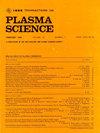关于离子源参数对氘钛离子流动和膨胀特性影响的粒子池内研究
IF 1.3
4区 物理与天体物理
Q3 PHYSICS, FLUIDS & PLASMAS
引用次数: 0
摘要
利用自编圆柱坐标二维三速度分量粒子入胞(2D3V-PIC)代码,研究了离子源参数对氘钛离子在真空装置中的流动和膨胀的影响。氘钛离子从离子源到膨胀杯的流动和膨胀特性受等离子体产生率、电子温度和多共振动能的影响,但几乎不受离子比例的影响。降低电子温度或等离子体生成率会削弱离子的径向膨胀能力。增加某一组分离子的动能也会削弱该组分离子的径向膨胀能力。但影响机制并不相同。降低电子温度或等离子体生成率会削弱离子源壁附近等离子体鞘中的电场强度。这种效应将削弱离子的径向加速能力。增加某一成分离子的动能会导致该成分离子的总速度从径向偏转到轴向。与 Ti2+ 相比,D+ 的流动和膨胀特性对离子源参数更为敏感。D+ 的离子萃取效率明显低于 Ti2+。在稳定阶段,轴向没有离子加速。离子加速只发生在径向。理论上分析了两种不同的径向离子加速机制。一种是鞘加速:离子被离子源壁附近的鞘形成的电场径向加速。另一种是膨胀加速,离子被膨胀杯中电子密度梯度形成的电场径向加速。理论结果很好地验证了模拟结果。本文章由计算机程序翻译,如有差异,请以英文原文为准。
Particle-in-Cell Investigation on the Influences of Ion Source Parameters on Flow and Expansion Characteristics of Deuterium-Titanium Ions
By using a self-programmed cylindrical coordinate 2-D, three velocity components, particle-in-cell (2D3V-PIC) code, the influences of ion source parameters on the flow, and expansion of deuterium-titanium ions in a vacuum device are investigated. The flow and expansion characteristics of deuterium-titanium ions from the ion source to the expansion cup are influenced by plasma generation rate, electron temperature, and kinetic energy of multicomponention, but hardly influenced by ion proportions. Decreasing electron temperature or plasma generation rate will weaken the radial expansion capabilities of ions. Increasing the kinetic energy of a certain component ion will also weaken the radial expansion capabilities of this component ion. But, the influence mechanisms are not the same. Decreasing electron temperature or plasma generation rate will weaken the electric field intensity in the plasma sheath near the ion source wall. This effect will weaken the radial accelerating capabilities of ions. Increasing the kinetic energy of a certain component ion will cause the total velocity of this component ion deflection from radial to axial direction. Compared with Ti2+, the flow and expansion characteristics of D+ are more sensitive to ion source parameters. The ion extraction efficiency of D+ is notably lower than Ti2+. In the steady phase, there is no ion-acceleration in the axial direction. Ion-acceleration occurs only in the radial direction. The two different radial ion-acceleration mechanisms are theoretically analyzed. One is sheath acceleration; ions are radially accelerated by the electric field formed by the sheath near the ion source wall. The other one is expansion acceleration, ions are radially accelerated by the electric field formed by the gradient of electron density in the expansion cup. The theoretical results well verify the simulated results.
求助全文
通过发布文献求助,成功后即可免费获取论文全文。
去求助
来源期刊

IEEE Transactions on Plasma Science
物理-物理:流体与等离子体
CiteScore
3.00
自引率
20.00%
发文量
538
审稿时长
3.8 months
期刊介绍:
The scope covers all aspects of the theory and application of plasma science. It includes the following areas: magnetohydrodynamics; thermionics and plasma diodes; basic plasma phenomena; gaseous electronics; microwave/plasma interaction; electron, ion, and plasma sources; space plasmas; intense electron and ion beams; laser-plasma interactions; plasma diagnostics; plasma chemistry and processing; solid-state plasmas; plasma heating; plasma for controlled fusion research; high energy density plasmas; industrial/commercial applications of plasma physics; plasma waves and instabilities; and high power microwave and submillimeter wave generation.
 求助内容:
求助内容: 应助结果提醒方式:
应助结果提醒方式:


